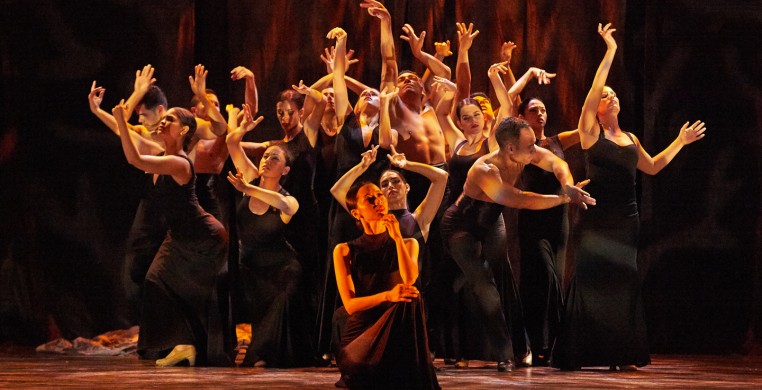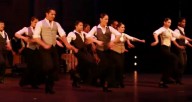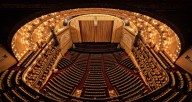The seething drama at the heart of Flamenco, Spain’s signature dance emblem, carried the day in Ensemble Español’s triumphant program at the Auditorium Theatre on Friday night in a fitting season opener for the Auditorium’s “Made In Chicago” series. ,
A truly home-grown arts institution, the Ensemble, in residence at Northeastern Illinois University since its inception 42 years ago, has grown under the guidance and inspiration of its founding director, Dame Libby Komaiko, and continues to flourish and explore new territory in the skilled hands of current artistic director Irma Suárez Ruiz and Executive Director Jorge Perez.
While faithfully representing the culturally-specific dance and music traditions of Spain, the Ensemble also forges new ground in forward thinking works that explore the fusion of modern dance, jazz, and African elements into a broader choreographic vision of Flamenco. This is a smart move for a company that aspires to be more than a living archive, and it assures engaging programming that balances traditional spectacle with innovative development of its genre.
One might think that infusion of outside influences would dilute the classic purity of Flamenco, but just the opposite was the case, especially in guest artist Carlos Rodriguez’s riveting solo, “Sentimiento” (2017), and his duet, “Luna Metalica” (2014). The physical drama inherent in Flamenco’s hair-trigger focal shifts, explosive rhythms, forceful arm gestures, and intricate hand articulations drove Rodriguez’s solo in expansive movement beyond standard Flamenco vocabulary. Open body lunges, pirouettes, and spiral turns built to an emotional peak of heel vibrations and leaps, ending in a spectacular aerial tour to the floor. The torso folding and fall and recovery of modern dance blended seamlessly with Flamenco’s upright defiance and audible foot rhythms to create compelling dramatic tension between flow and attack.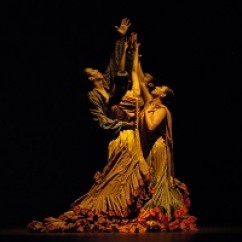 Ecos De España
Ecos De España
Guest Artist Angel Rojas’ “Defalla, Fur de la Caja” (2017) takes Flamenco literally “out of the box,” paying homage to composer Manuel de Falla’s 1919 ballet “The Three-Cornered Hat.” Dozens of colorful traditional Spanish dance costumes suspended from beams hang over the space as dancers in modern street clothes wander on stage, curious to inspect them. Casual spoken dialogue among the dancers (“We are so late!”) tells us they are about to rehearse. They are glib, hip, and have “attitude” written all over their body language, which Rojas ingeniously translates into Flamenco moves, giving us the novel pleasure of viewing the bare bones of Flamenco’s shape stripped of its many-layered skirts, flounces and ruffles. The suspended costumes fly out of sight, along with the stage’s masking draperies, to reveal a naked backstage, its brick walls, industrial scaffolding, theatrical lighting instruments, and technical crew. Here jazzy free-flow and contemporary sensibility set the classic “olé” of Flamenco free in a fun romp. It all ends in the traditional costumes dropping down from above into a limp pile across the front of the stage, as if to say, in a sentimental nod to the past, “Flamenco lives beyond these!”
Opening Act 2, Carlos Rodriguez and Angel Rojas’ “Iroko” (2016) begins in a sculptural tableau of dancers silhouetted under a drape upstage. Arms emerge from the abstraction, mirroring the projected tree branches across the upstage cyclorama. Slow, deliberate movements alternate with sharp focus changes to a soundscape of drumming, hand claps, and stomping, culling Flamenco’s roots in African dance in a decisively modern dance feel. The women in sleek black gowns, men in black slacks evolve jazz postures gradually toward Flamenco, becoming increasingly traditional, with multiple corresponding costume changes, fringed shawls and flounced trains. Jazz hands and shoulder isolations meld with the staccato of Flamenco heels, but the dominant gesture of the piece is the sudden thrust of arms from high overhead downward toward the floor. The characteristic Flamenco attack of this movement typifies the dramatic sizzle that pervades the entire evening.
Live music, performed on stage by guitarist David Chiriboga, percussionist Javier Saume-Mazzei, and Flamenco singer Patricia Ortega, injects the very soul of Spain directly into our hearts, Ortega’s haunting voice topping the somewhat worn recorded sound of music used for the larger danced numbers. The musicians, along with an unlisted violinist, perform both musical interludes and accompaniment for solo dancer Irma Suárez Ruiz, whose mesmerizing rendering of classic Flamenco style embodies impressive depth of artistry. From the extraordinary subtlety of her pliant spine to the tactile articulations of her hands and fingers and audible rhythmic counterpoint of her exacting feet, she is at one with the music.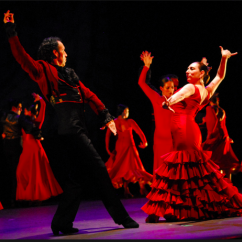 Jorge Perez and Irma Suárez Ruiz
Jorge Perez and Irma Suárez Ruiz
Guest tenor Luis Galvez and guest soprano Erica Rose Sauder spice up the street scene in the program’s picturesque opener, “Madrileño,” (1989) choreographed by Suarez and guest artist Paco Alonso. The lively piece showcases Ensemble Español’s versatile theatricality and technical polish across a range of Spanish dance forms, and gives some of its youngest dancers from its Youth Company a chance to shine.
No review of Ensemble Español would be complete without touching on Dame Libby’s closing masterwork, “Bolero” (1993), set to the well-known and oft-used Ravel score, with projections of the paintings of Pablo Picasso. As many times as I have seen the Ensemble’s “Bolero,” I never cease to marvel at Komaiko’s understanding of the music’s structure and how brilliantly she captures its suspense and high drama in choreography that activates every nuance of the music in constantly shifting movement motifs. Komaiko’s “Bolero” is a living testament to Flamenco’s universality as a concert dance idiom, and Ensemble Español’s pioneering “Made In Chicago” program promises its continuing development for a bright and relevant future.

